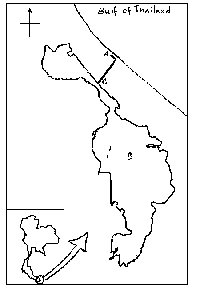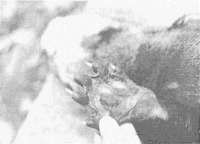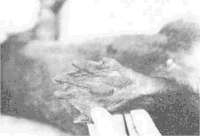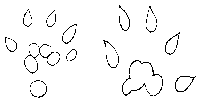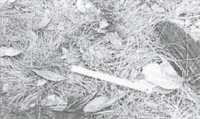 |
Last Update:
Thursday November 22, 2018
|
| [Home] |
|
Volume 18 Issue 2 Pages 54 - 101 (October 2001) Citation: Kanchanasaka, B. K.(2001) Tracks and Other Signs of the Hairy-Nosed Otter (Lutra sumatrana). IUCN Otter Spec. Group Bull. 18(2): 57 - 63 Tracks and Other Signs of the Hairy-Nosed Otter (Lutra sumatrana) Budsabong Kanchanasaka Wildlife Research Division, Forest Technical Bureau, Royal Forest Department, Paholoyothin rd., Chatujak, Chatujak, 10900 Bangkok, THAILAND. kbudsabong@yahoo.com (received 2 August 2001, accepted 5 November 2001)
INTRODUCTION Four species of otters are known to exist in Thailand (Lekagul and McNeely, 1977). The smooth coated otter (Lutra perspicillata), the Eurasian otter (L. lutra), and the small-clawed otter (Amblonyx cinereus) are all known to occur and their status has been assessed in many areas (Kruuk et al., 1994; Kanchanasaka, 1996, 1997). Though the hairy-nosed otter (Lutra sumatrana) was believed to occur in southern Thailand (Lekagul and McNeely, 1977), there had been no report or reliable information on this otter species for a long time; it was therefore considered to be a highly endangered species within its range in Thailand. The recent rediscovery of the hairy nosed otter in the Toa Daeng peat swamp forest in southern Thailand has allowed us to begin an intensive study of this species, including information on tracks, spraints, spraint sites, and diet composition, allowing us to increase the information available on the hairy nosed otter. METHODS Observations were made in a patch of swamp forest that was dominated by Melaluca cajeputi. This forest patch was about 0.5 km2 and is situated near a canal connecting the forest to a large patch of peat swamp forest (Fig. 1). Approximately 10 spraint sites were found in this area and 'camera trapping' was used to check on use by the species. Direct observations were made whenever the opportunity arose.
Tracks were studied by collecting a plaster cast of print, and these were compared with the tracks of the smooth coated otter and the Eurasian otter from previously published material (van Strien, 1983; Brown et al., 1983). Spraint sites were recorded and compared with other Asian otters and the size and shape of the spraints were recorded. Spraint composition was analysed in order to differentiate the diet of hairy nosed otters from that of other otters. Diet composition is presented as frequency of occurrence (FO), relative frequency (RF), and bulk percentages (BP). The frequency of occurrence shows the percentage of spraints containing a particular prey item and the relative frequency, the number of occurrences of a particular item as a percentage of the total number of occurrences of all items in the sample (sum = 100%). RESULTS Observations From information gathered from both 'camera trapping' and direct observation, we estimated that one group of three otters inhabited this area. Description of tracks Tracks of the hairy nosed otter showed five toes on each foot, as with other otters. The web between the toes was often clear in soft substrate. The toes are small, pointed and often showed the imprint of the claw on sand or mud. The toe width is about 0.7 to 1.1 cm. The footprint of the hairy nosed otter is both smaller and less oval than the smooth coated otter, but similar to the track of the Eurasian otter, in both size and shape. The first and the fifth toe are not aligned and it is possible to separate the fore and hind feet from the position of the first and the fifth toes, i.e. the first toe in the hind foot is lower than the fifth toe to a much greater degree than in the fore foot. The position of the five toes in the fore foot is therefore more symmetrical than in the hind foot. The fore feet often showed four inter-digital and proximal pads, while the proximal pads are absent in the hind feet (Fig. 2-4). The fore feet are rather smaller than the hind feet (Fig. 4), the approximate width of the fore feet being 5.8 cm (n=24) and the hind feet 6.6 cm (n=16). Although there were distinctions between the tracks of the three Asian otter species, the footprint of the hairy nosed otter and the common otter are very difficult to distinguish. The width of the footprint of the hairy nosed otter is slightly larger than that of the common otter, however, the width of some footprints overlapped with that of the common otter and, though the toe was rather small in size and pointed in shape, they were also very similar. Spraints and Spraint sites Hairy nosed otters deposit their faeces, or spraints, at similar sites to the other otter species. Most spraints were found on the ground and, whereas some were found in the shade of a tree, many were found on a mound in the open. Because hairy nosed otters live in swamp forest, where the forest floor is covered by water, many of the spraint sites were on a mound near a tree trunk or on the trunk or root of a fallen tree. Spraint sites could be as close as 2-5 metres apart and were situated near the waters edge, approx. 0.5 to 2 meters from the bank, or on a mound surrounded by water, at least 0.3 metres above the water level. The hairy nosed otter did not appear to produce a large pile of spraints, such as small-clawed and smooth coated otters do; however, they appeared to defecate frequently along a path. Spraints were shapeless, black in color when fresh, and did not have a strong smell like the smooth coated otter. Some spraints contained a green/brown mucous. The size and shape of spraints varied, from a tiny scat, a shapeless dropping (Fig. 5), to a cylindrical spraint (Fig. 6), usually around 1-1.5 cm in diameter. Some spraint sites contained 2-3 shapeless droppings, about 5 x 2.2 cm in size, whereas others had a single dropping, approximately 4.5 x 2.2 cm in size. Spraint sites on a tree trunk or log had both single tiny scats and multiple spraints of small dropping, with the multiple spraints often deposited on the base of a big tree. The single tiny spraint, sometimes containing only mucous, usually placed on a log or tree trunk, were often as close as 1 metre apart.
Spraint composition One hundred and twenty two spraints were collected over the nine months between March and November 2000 this period covering both the wet and dry seasons in southern Thailand. Vertebrae were the remains most often found in spraint (Frequency occurrence: FO = 99.2 %, Relative frequency: RF = 93.8%), most of these being from fish (FO = 98.4 %, RF = 78.6 %), with snake being the second most important item (FO = 18 %, RF = 13.5). Invertebrate remains were also found, including crab and insect, though the latter were only found in small quantities (Table 1). The results indicate that fish were the main food item of the hairy nosed otter throughout the study period, with other vertebrates and invertebrates taken in small amounts. DISCUSSION Our observations on tracks suggest that the tracks of the hairy nosed otter and the Eurasian otter are very similar and will be difficult to separate from each other if these two species occur in the same area. However, the tracks of hairy nosed otters and the smooth coated otter are different and can be separated by their size. The tracks of the smooth coated otter are large and often more than 8 cm wide (Kruuk et al., 1993). Whilst the track width of young or small female smooth coated otters can be smaller than 8 cm, their toes will be bigger and their shape oval, whereas the tracks of the hairy nosed otter are rather small and have pointed toes. The tracks of the hairy nosed otter and the small-clawed otter, the other otter species that shares the swamp forest habitat, are completely different in their shape and size. The small-clawed otters' footprints are smaller than 4.5 cm in width and never show claw marks (Kruuk et al., 1993). According to Kruuk et al. (1993), there was large variation and overlap in appearance among the faeces of the three otter species (L. lutra, L. perspicillata and Aonyx cinerea) and hence evidence from spraint sites should be used with caution. The results of this study supported these findings, with some spraint types of the hairy nosed otter being very similar to those of the smooth coated otter and the Eurasian otter. However, the type of spraint comprising many small droppings of faeces of the same age on a tree trunk belonged only to the hairy nosed otter. Analysis of spraint composition indicated that the diet of the hairy nosed otter in this region contained many more fish remains than other vertebrate or invertebrates, similar to the diet of the smooth coated otter; whereas spraints of the Eurasian otter contain roughly equal amounts of amphibian or crab as fish (Kruuk et al., 1994; Kanchanasaka 1997). ACKNOWLEDGEMENTS - The International Otter Survival Fund and the Japanese Otter Research Group financially supported this project. I would also like to thank WWF-Thailand and the International Otter Survival Fund for supporting my participation in the VIIth International Otter Colloquium. REFERENCES Brown, R.W., Lawrence M.J., Pope. J. 1984. Animals Tracks,
Trails and Signs. Reed International Books Limited. London. Résumé : Traces et autres
Indices chez la Loutre de Sumatra en Thaïlande Resumen: Huellas y Otros Signos de la Nutria
de Hocico Peludo |
||||||||||
| [Copyright © 2006 - 2050 IUCN/SSC OSG] | [Home] | [Contact Us] |
